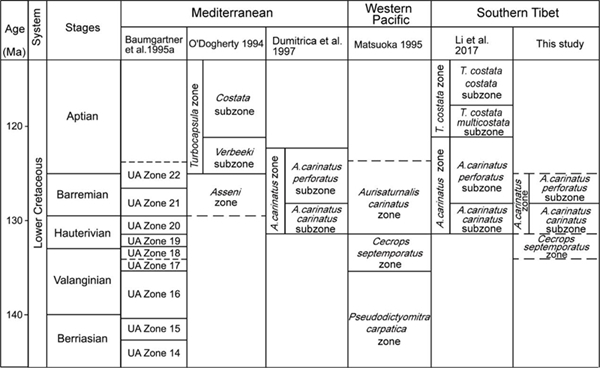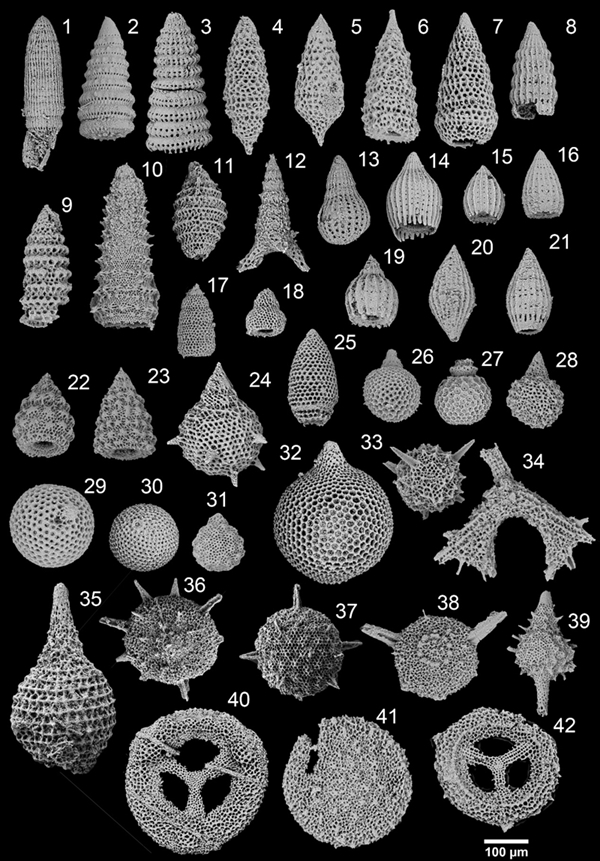The Yarlung Tsangpo suture zone (YTSZ) marks the collision boundary between the Eurasian Plate and the Indian Plate and remains geological records of the disappeared Neo-Tethyan ocean, which is a hotspot on the study about the Neo-Tethyan ocean evolution and the Qinghai-Tibet Plateau uplift. The YTSZ consists of eastern (Qushui–Motuo), central (Angren–Renbu) and western (Saga to the boundary of India–China) three segments. Until now, most radiolarian investigations have been undertaken in the eastern and central segments. Less radiolarian studies have been done in the western segment, especially those involving any systematic research on the biostratigraphy and paleobiogeography of the radiolarians.
In recent years, well-preserved Jurassic-Cretaceous radiolarian fossils have been collected within the western YTSZ by the research group of Prof. LUO Hui from the Nanjing Institute of Geology and Paleontology, Chinese Academy of Sciences (NIGPAS). Ph.D. candidate CUI Xiaohui and others from this group, cooperating with Prof. Jonathan C. Aitchison from the University of Queensland in Australia, make a detailed analysis of Early Cretaceous (Hauterivian to late Barremian) radiolarians from Jiangyema section in the west segment of the YTSZ. The results have been published in the international geological research journal Cretaceous Research.
Two radiolarian zones and two subzones are recognized and respectively named as the Cecrops septemporatus zone, Aurisaturnalis carinatus zone, Aurisaturnalis carinatus carinatus subzone and Aurisaturnalis carinatus perforatus subzone. They can be correlated well with coeval radiolarian biozones between western Tethys and/or Japan, which provide a better biostratigraphical framework and reliable age constraints for parts of the Neo-Tethyan Ocean floor that were subducted beneath supra-subduction zone (SSZ) ophiolites in the western part of the YTSZ.
Comparison of geochemical characteristics on discriminant graphs suggests that the bedded cherts were deposited in a deep oceanic basin near a continental margin. These results and integration of available radiolarian studies along the YTSZ suggest that the Neo-Tethys was a deep ocean between the Indian and Eurasian continents in which pelagic sedimentation was on-going until at least late Barremian time.
This research was supported by the National Natural Science Foundation of China, the Strategic Priority Research Program of Chinese Academy of Sciences and the Second Tibetan Plateau Scientific Expedition and Research.
Reference: Cui, X.H., Luo, H., Jonathan C.A., Li, X. Fang, P.Y., 2021. Early Cretaceous radiolarians and chert geochemistry from western Yarlung Tsangpo suture zone in Jiangyema section, Purang county, SW Tibet. Cretaceous Research, 125 104840. https://doi.org/10.1016/j.cretres.2021.104840.

Simplified geological map of the Purang ophiolitic melange showing the location of studied section (modified after Liu et al., 2011)

Comparison of Early Cretaceous radiolarian zones (modified after Gorican et al., 2018; Li et al., 2017)

Scanning electron micrographs of selected radiolarians from siliceous samples in the Jiangyema section (1)

Scanning electron micrographs of selected radiolarians from siliceous samples in the Jiangyema section (2)
Download:
